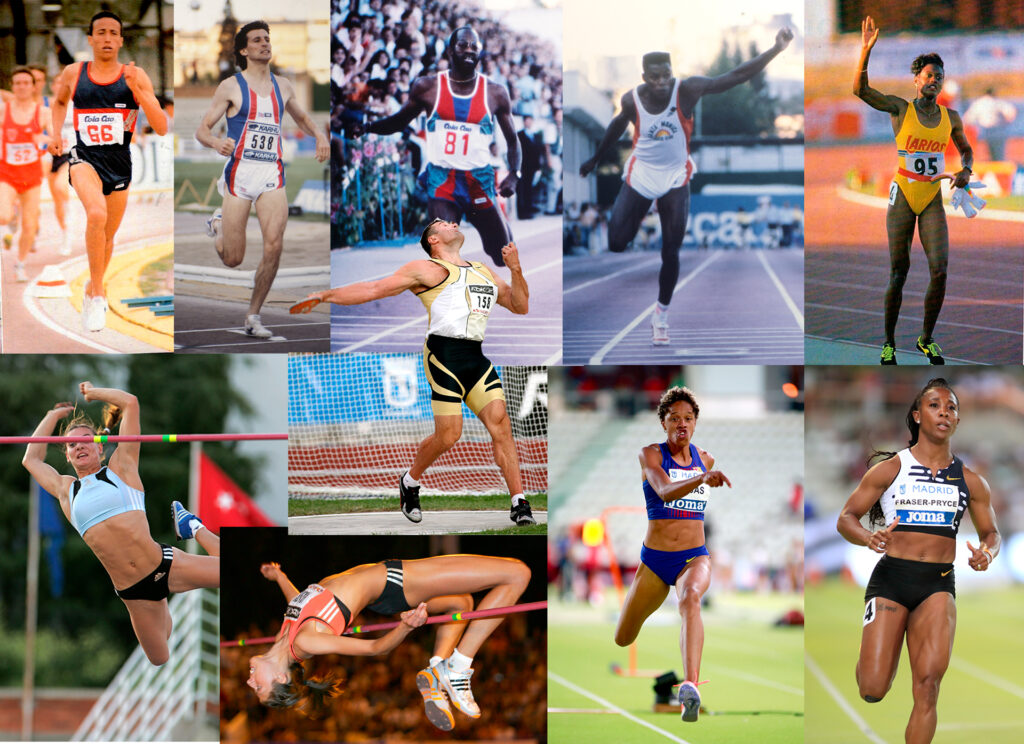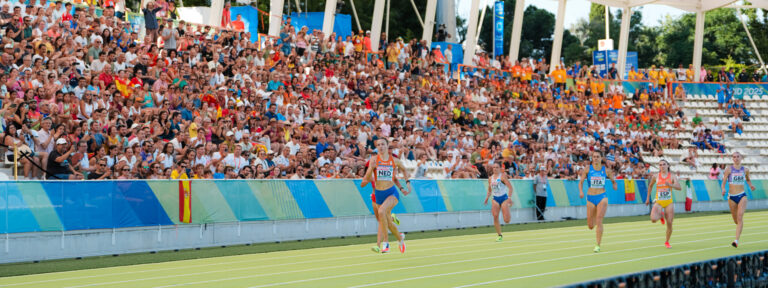As the European Team Championships draw near, set to take place at the end of June on the green synthetic track of Madrid’s Vallehermoso Stadium, we continue our journey back in time. In this second and final installment, we celebrate ten more legendary athletes who graced the track at Vallehermoso, both in its old and new iterations.
By Miguel Villaseñor
Saïd Aouita
On June 4, 1985, during that year’s Madrid Meeting, Saïd Aouita attempted a world record in the unusual 2000-meter distance. The Moroccan had expressed his ambition to hold all world records between 1500 and 5000 meters, a highly ambitious goal. The 2000-meter record, held by New Zealander John Walker with 4:51.52 set in 1976, was nine years old. However, that afternoon in Vallehermoso, the pacemakers didn’t perform as expected, and it quickly became clear that a record was nearly impossible. When the pacemakers dropped out, the Moroccan regained some lost time and, true to form, displayed the class and grit that, fueled by the crowd’s incessant cheers, led him to a time of 4:54.98 – not enough for his objective. Behind him ran José Luis González from Toledo, in a race that foreshadowed his fantastic summer of 1985, a year in which he broke the national records for 1500 meters and the mile. Aouita, for his part, finished that year as the 1500m and 5000m record holder. In 1987, he finally claimed the 2000m record that eluded him in Madrid. From 1989 to 1992, he simultaneously held all world records in metric distances from 1500m to 5000m, although he never achieved the mile record.
Sebastian Coe
The current president of World Athletics, Britain’s Sebastian Coe, was, as we all know, a magnificent athlete and one of the most charismatic and admired middle-distance runners in history, a double Olympic champion in the 1500 meters in 1980 and 1984. I recall that in 1981, he was in Madrid to receive an award, and even then, without competing, he filled newspaper pages and television minutes. In 1986, he did compete in our capital, at Vallehermoso, in the Gran Premio Internacional Papel Galgo. Two Britons shone at that meeting. In the sprints, Linford Christie surprised everyone by running the 100 meters in 10.04, a British record and the best mark ever achieved in Spain. Christie would go on to become Olympic champion six years later in Barcelona 1992. And in the 800m, the graceful figure of Sebastian Coe emerged. With his elegant stride on the track, he delighted the crowd and won the event with a time of 1:45.66. That year, Coe would be crowned European champion in the 800 meters and runner-up in the 1500m in Stuttgart.
Edwin Moses
The 1987 Madrid Meeting at Vallehermoso witnessed an event that captivated the attention of the athletics world and filled hours of television and newspaper pages. American Edwin Moses, Olympic and world champion and world record holder, lost his 9-year, 9-month, and 9-day unbeaten streak in the 400-meter hurdles. Moses had last lost on August 25, 1977, to the German Harald Schmid, his great rival for many years. After 122 victorious races and the aforementioned period, Edwin Moses once again tasted defeat. This came at the hands of another American, Danny Harris, whom he hadn’t faced since the 1984 Olympic final. In that 1987 race, Harris was always ahead, but in the final straight, Moses narrowed the gap, giving the impression he would ultimately win again. However, Edwin Moses stumbled slightly on the last hurdle, something very unusual for him, losing precious time that cost him the race. They were separated by 13 hundredths of a second at the finish line: 47.56 to 47.69. Edwin Moses took ample revenge that summer at the World Championships in Rome, where he was crowned champion again, with only a 2-hundredth advantage over Harris.
Carl Lewis
At that same 1987 Madrid meeting, the packed stands of Vallehermoso had a fabulous time watching one of the greatest athletes in world history, an athlete who was perhaps the best in those days: American Carl Lewis, a four-time Olympic champion in 1984. He won the 100m with 10.12, and an hour later, as the culmination of a glorious afternoon of athletics, the 200 meters were scheduled. This writer, on the 200m bend and leaning against that classic fence separating the Vallehermoso stands from the track, was an exceptional witness to the preparations for the event. When the starting gun fired, all the athletes left their blocks… except Carl Lewis, who simply didn’t start. The judge, seeing the situation, was quick and skillful in his decision, nullifying the start with another gunshot. The runners returned to their blocks; the smile of Calvin Smith, 100m world record holder and Carl’s rival that day, clearly indicated that nothing strange had happened, simply that Lewis hadn’t started. Finally, the definitive start was given, and Carl Lewis flew over the fast Madrid track, and aided by a favorable wind of 1.3 m/s, he stopped the clock at 19.92, just 20 hundredths off the then-world record. “The Son of Wind” left his mark, and how, on the Vallehermoso stadium. That mark was the best world mark of 1987 in the distance, and the best mark ever achieved on European soil up to that moment.
Merlene Ottey
This article couldn’t be complete without an athlete like Merlene Ottey, a true legend in the history of women’s sprinting, with an incredibly long career spanning four different decades, from the late 1970s to almost the 2010s. The Jamaican (and Slovenian in her later years as an athlete) was a regular on our tracks and we saw her many times in Spain: Barcelona, Seville, Vigo, Granada… and Madrid. At the 1990 meeting in Vallehermoso, she had to battle a 2.0 m/s headwind and still stopped the clock at 11.06. She had just run a stratospheric 10.78 in Seville with a generous but legal wind, but the god Aeolus was not on her side on the Madrid track. Merlene Ottey is also remembered in the capital for her sensational world record of 6.96 in the 60 meters on the old track of the Palacio de los Deportes, at the 1992 Cagigal Memorial. This record only lasted a year for the Jamaican, as Russia’s Irina Privalova snatched it from her at the same venue.

Virgilijus Alekna
In recent weeks, Mykolas Alekna has been in the news thanks to his new world record in discus throw. Now we will talk about Mykolas’s father, the great Lithuanian thrower Virgilijus Alekna. The Lithuanian giant, 2.02 meters tall (4 cm taller than his son) and with a very unusual arm span of 2.24 meters, competed three times in Vallehermoso, at the Madrid Meeting in 2005, 2006, and 2007. He won all three times, the first with a throw of 70.67m, which was the best world mark of 2005. Let’s remember that Alekna participated in five Olympic Games, from 1996 to 2012, and won gold in Sydney 2000 and Athens 2004, and world gold in 2003 and 2005. Therefore, in 2005 and 2006, he arrived in Madrid as the reigning Olympic and world champion. To top it off, he was European champion in 2006, so in Madrid 2007, he appeared with the triple crown in his bag, something that has happened very few times in the capital of Spain. A statistical curiosity: in his three triumphs in Vallehermoso, Alekna’s winning throw came in his fifth attempt. The Lithuanian was a regular in Madrid, as he also competed in the Madrid meetings of 2003 (at the Estadio de la Comunidad) and 2008 and 2009 (in Moratalaz). His worthy heir, Mykolas, only 22 years old, has not yet competed in Madrid or Spain. We hope to see him soon on our land.
Yelena Isinbayeva
The greatest pole vaulter in history, Russia’s Yelena Isinbayeva, competed in Vallehermoso on July 16, 2005. Shortly before, in the same year, she had also been in Madrid, at the European Indoor Championships in the Palacio de los Deportes, where she was crowned champion with a world record of 4.90m. That July 16th, fans hoped she would break the world record again. It wasn’t an unreasonable wish, as she had done it 11 days earlier in Lausanne with 4.93m. In Vallehermoso, she began jumping when all her rivals had been eliminated. But the initial height of 4.65m was a challenge, as she cleared it on her third attempt. From there, she directly raised the bar to 4.95m, which she cleared on her second attempt, setting a new world record. However, the Madrid record lasted a very short time, only six days, as in London, on July 22, the Russian broke it again with 4.96m and 5.00m.
Blanka Vlašić
Croatian high jumper Blanka Vlašić attempted to break Stefka Kostadinova‘s 2.09m world record 60 times but never succeeded. Three of those attempts were in Vallehermoso on July 21, 2007, in the last major competition held at the old stadium. After clearing 1.98m, she had already won the event. But she wanted to go little by little: the bar at 2.01m, which she cleared on her first attempt; then at 2.05m, also cleared on her first attempt (which was a personal best and a Croatian record). It seemed that this was going to be the day. She took all the necessary time with 2.10m. She was very close to clearing it but failed in all three attempts. The following year, at the 2008 Madrid meeting, already on the Moratalaz track, the story repeated itself. This time 2.06m and three new unsuccessful attempts at 2.10m.
Yulimar Rojas
The close relationship between Spain and Venezuelan athlete Yulimar Rojas is well known. She is a world record holder, a seven-time world champion (four outdoors and three indoors), and an Olympic champion in the triple jump at Tokyo 2021. Yulimar resides in Spain, in Guadalajara, and trains under Iván Pedroso. Naturally, our beloved Venezuelan has competed in Spain countless times, and on two occasions, she has done so at the Vallehermoso stadium, both times with great sporting results. At the 2021 Madrid meeting, Yulimar Rojas won with a jump of 15.34m (aided by a +2.2 m/s wind), plus another legal jump of 15.19m. In the 2023 Iberdrola League final, representing FC Barcelona, the Venezuelan reached 14.96m, naturally a competition record. Additionally, Yulimar Rojas is remembered in Madrid for her indoor world record at the Gallur Sports Center during the 2020 international meeting, where she was the star; she jumped 15.43 meters, just 7cm shy of the “absolute” world record of 15.50m, a record she surpassed at the Tokyo Games and later at the 2022 Belgrade Indoor World Championships.
Shelley-Ann Fraser-Pryce
Jamaica’s Shelley-Ann Fraser-Pryce, then the reigning Olympic and world champion, was the star of the 2023 Madrid Meeting held in Vallehermoso. As expected, Shelley-Ann claimed victory. She had made a brilliant comeback two days earlier in Lausanne, where she won a 100m with a great time of 10.82s. The Jamaican arrived, conquered, and convinced with immense clarity and a mark of 10.83s (the best ever achieved in the capital), with practically no wind (-0.1m/s), just one hundredth of a second off her time from a couple of days prior. The acceleration of the triple Olympic champion (and ten-time world champion) was simply extraordinary, and with the aforementioned 10.83s, she set a new meeting record. She ran in lane four, and to the left of the Jamaican was Barcelona’s Jaël-Sakura Bestué, who magnificently took advantage of the Caribbean’s slipstream, stopping the clock at 11.10s, finishing in second place and achieving a personal best, very close to the Spanish record.



